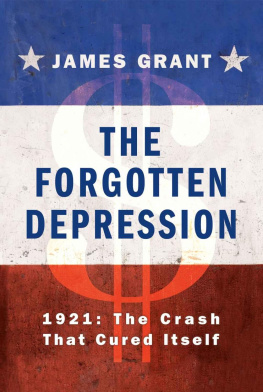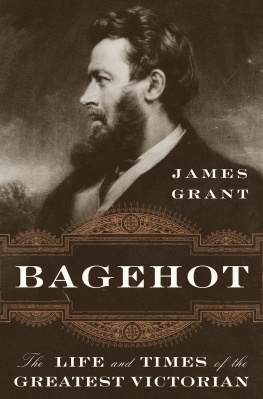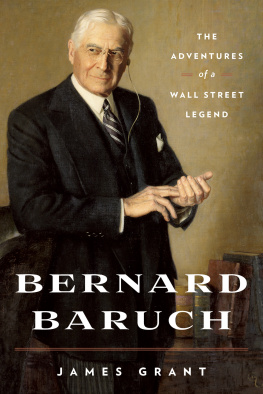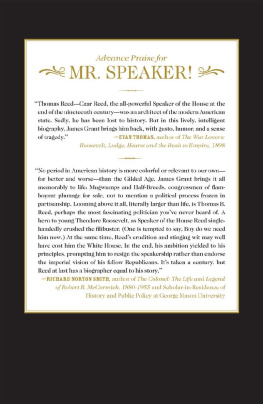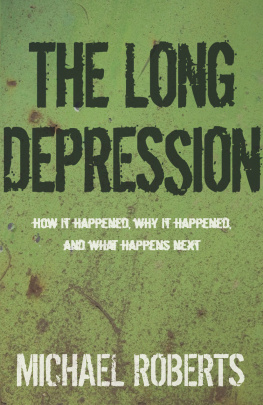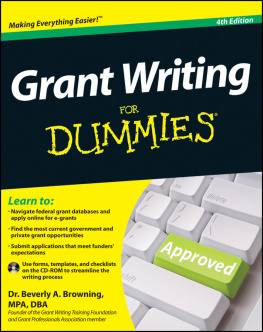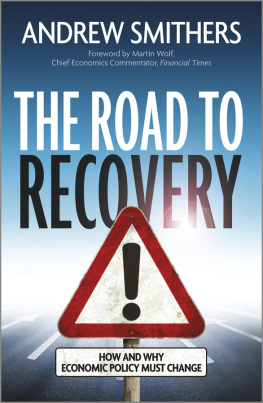Thank you for downloading this Simon & Schuster eBook.
Join our mailing list and get updates on new releases, deals, bonus content and other great books from Simon & Schuster.
C LICK H ERE T O S IGN U P
or visit us online to sign up at
eBookNews.SimonandSchuster.com
CONTENTS
In memory of A. Alex Porter, investor, scholar, bon vivant.
In the economy, an act, a habit, an institution, a law, gives birth not only to an effect, but to a series of effects. Of these effects, the first only is immediate; it manifests itself simultaneously with its causeit is seen. The others unfold in successionthey are not seen: it is well for us if they are foreseen.
Frederic Bastiat, That Which Is Seen, That Which Is Unseen, 1850
PREFACE
T his slim volume describes a weighty and wonderful event. In 1920, the American economy entered what would presently be diagnosed as a depression. The successive administrations of Woodrow Wilson and Warren G. Harding met the downturn by seeming to ignore itor by implementing policies that an average 21st century economist would judge disastrous. Confronted with plunging prices, incomes and employment, the government balanced the budget and, through the newly instituted Federal Reserve, raised interest rates. By the lights of Keynesian and monetarist doctrine alike, no more primitive or counterproductive policies could be imagined. Yet by late 1921, a powerful, job-filled recovery was under way. This is the story of Americas last governmentally unmedicated depression.
The United States was not without a government in the early 1920s, of course. It taxed and regulated. It furnished courts, the rule of law, a dollar defined in law as a weight of gold and an army and navy. Federal officers examined the nationally chartered banks. Other public officials infused illiquid though solvent banks with cash. Contemporaries credited the latter functionariesnew hires of the Federal Reservewith forestalling an otherwise certain money panic. What the government did not do was socialize the risk of financial failure or attempt to steer and guide the national economy by manipulating either the rate of federal spending or the value of the dollar. Compared to the federal establishment that would take form in the 1930s (or to that which had recently waged the war against Germany), it was a small and unintrusive government.
The hero of my narrative is the price mechanism, Adam Smiths invisible hand. In a market economy, prices coordinate human effort. They channel investment, saving and work. High prices encourage production but discourage consumption; low prices do the opposite. The depression of 192021 was marked by plunging prices, the malignity we call deflation. But prices and wages fell only so far. They stopped falling when they became low enough to entice consumers into shopping, investors into committing capital and employers into hiring. Through the agency of falling prices and wages, the American economy righted itself.
I write in the fifth year of a historically lackluster recovery from the so-called Great Recession of 200709. To address the crisis of failing banks and collapsing credit, the administrations of George W. Bush and Barack Obama borrowed and spent hundreds of billions of dollars. They threw a governmental lifeline to dozens of financial institutions, some of which would have otherwise drowned. The Federal Reserve pushed its money-market interest rate to zero and materialized trillions of new dollars (thereby further subsidizing the banks and government-sponsored enterprises whose errors of omission and commission had helped to precipitate the crisis in the first place). Yet for all these exertions, some 9.8 million Americans remain out of a job while millions more have given up hope of finding one.
Just about no one with a public voice nowadays would dare to propose the policies that the government implemented (or, more to the point, refused or neglected to implement) almost a century ago. But the fact is that, in the wake of those decisions, growth resumed and the 1920s proverbially roared. We cant know what might have been if Wilson and Harding had intervened as presidents of the late 20th and early 21st centuries are wont to do. Herbert Hoover, Hardings secretary of commerce, was seemingly champing at the bit to act; the slump was ending by the time he swung into action. When, as the 31st president, Hoover did intervenenotably, in an attempt to prevent a drop in wagesthe results were unsatisfactory.
Recessions and depressions dont announce their own arrival. Economists rather piece together the chronology after the fact. The recognized arbiter of the cyclical calendar, the National Bureau of Economic Research, dates the start of the downturn of 192021 in January 1920 and its conclusion in July 1921; which is to say that things stopped getting better in January 1920, and they stopped getting worse in July 1921. The elapsed time was 18 months.
On the one hand, a year and a half is a very long time to any who suffered unemployment, bankruptcy or destitution. On the other, it is a great deal shorter than the 43 months of the Great Depression of 192933. I propose that constructive federal inaction contributed to the relatively satisfactory outcome. To the financiers and capitalists weaned on the idea of laissez-faire, federal passivity did not destroy confidence but rather enhanced it.
Confidence is a concept as vital as it is amorphous. What imparts a feeling of trust to one generation may frighten another. What seemed to brace up the generation of Americans who confronted the 192021 slump was a collective belief in the underlying soundness of American finance. In a world that in many ways had seemed to have lost its moorings, the dollar was still as good as gold. A bipartisan determination to pay down the federal debt and to protect the purchasing power of the U.S. dollar thus likely contributed to a belief that the bad times couldnt and wouldnt last.
If a government wishes to alleviate, rather than aggravate, a depression, its only valid course is laissez-faireto leave the economy alone, wrote Murray Rothbard in his history of the 1930s, Americas Great Depression. Only if there is no interference, direct or threatened, with prices, wage rates and business liquidation, will the necessary adjustment proceed with smooth dispatch. Whatever might be said about that proposition in general, the American experience in 192021 and 192933 does not disprove it.
The Great Depression was the historical touchstone of the advocates of a muscular federal response to our own Great Recession. It was to close the door on any possible repetition of the experience of the early 1930s that the Federal Reserve, under the leadership of Chairman Ben S. Bernanke, embarked on a radical program of money printing, interest-rate suppression and financial market manipulation, policies still in place more than five years after economic healing officially began. In a speech at Jackson Hole, Wyoming, in August 2012, Mr. Bernanke candidly described these experiments as learning by doing.
There was no such improvisation in the monetary and fiscal councils of 192021, unless the refusal of the still unseasoned Federal Reserve to budge from its policy of high interest rates even in the teeth of plunging prices can be viewed as experimental. In any case, to the best of my knowledge, no American policy-maker invoked the extraordinary events of 192021 as a potentially relevant precedent during the crisis of 2008; the collapse of 192933 rather monopolized the market in historical analogy. One can anticipate the arguments in defense of this choice. Thus, in 192021, the economy was much smaller than it is today. The political environment was wholly different than ours and the statistics produced to measure the expansion and contraction of economic activity were, at best, crude. Besides, there was no federal safety net and no easily accessible credit, either of the personal or mortgage variety. All this is true, yet each objection might be applied with nearly equal force to the Great Depression itself.
Next page
